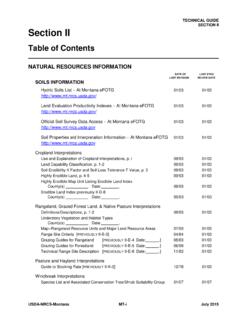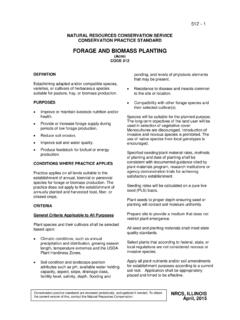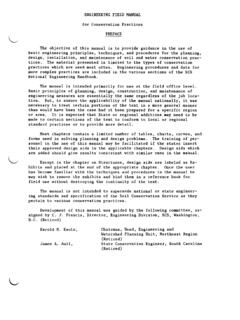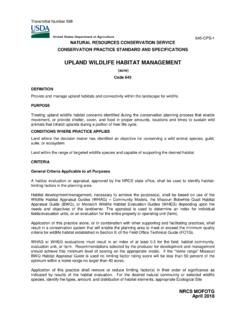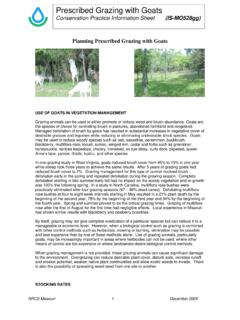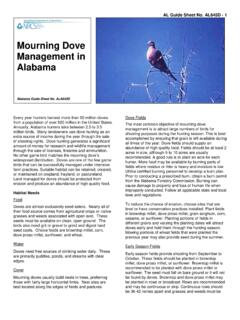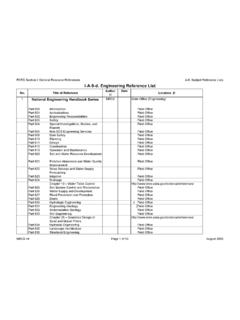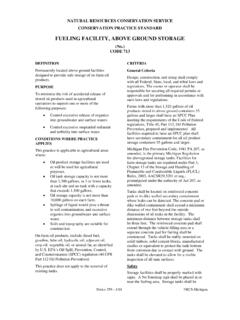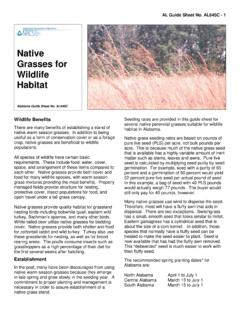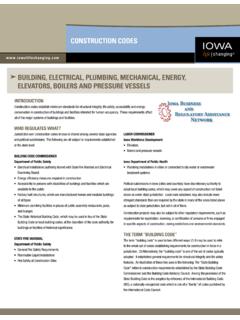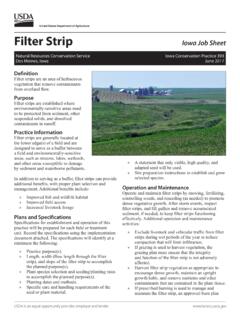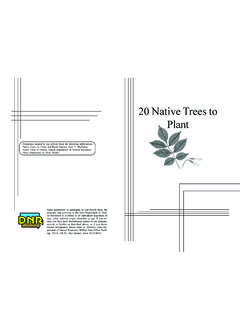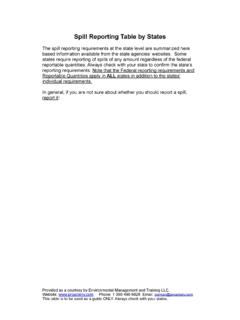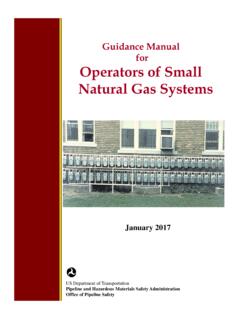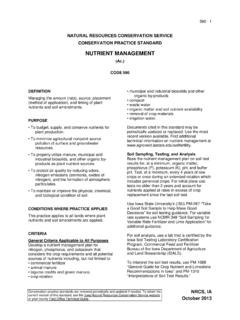Transcription of United States Department of Agriculture Natural Resources ...
1 Page 1 of 4 August 2018 C United States Department of Agriculture Natural Resources Conservation Service over Crops provide numerous benefits, and these are greatest when a good stand is established with as little soil disturbance as possible. To maxi- mize benefits and to meet the criteria of the FOTG- 329- Residue and Tillage Management Standard, theseeding tool or method should have a calculatedSoil Tillage Intensity Rating (STIR) rating of 15 or lessaccording to the Revised Universal Soil Loss Equation(RUSLE2).Cover Crop Establishment Cover Crop success is dependent on several factors: Seeding date Weather (temperature and moisture) after seeding Seedbed conditions Fertility Mulch or previous crop residue amounts Planting depth Seed soil contact Seeding rate Seed quality (% germination and % purity) Time of freeze after seeding Insects and diseasesSeeding Depth Guidance Groups Optimum Maximum Brassicas, Clovers, Small Seeded Legumes, Small Seeded Grasses 1/4 3/4 Vetches, Sorghums 1/2 1 Cereal Grains 3/4 1 1/2 Beans, Peas 1 1/2 2 Cover crop mix with excellent establishment.
2 The following are recommended seeding methods and tools which optimize establishment factors. Each has been evaluated for their relative establish- ment effectiveness for: depth control, seed to soil contact, timeliness and weather conditions. No-Till Drilling: Use a no-till drill that is designed to handle heavy crop residues and the type of seed being planted (espe- cially important for small seeded species). Set properly, the no- till drill will provide good seed-to-soil contact and a planting depth preferred for the desired species to be planted. This should provide for faster and more con- sistent emergence and is recommended for seeding species during the final days of the approved seeding period.
3 Depth control for most drills is not as precise as a planter, so it is important to set it for the opti- mum depth, and check often to assure placement doesn t exceed the maximum depth for selected spe- cies. Drilling in soils that are too wet can also cause improper seed placement and be antagonistic to the desired soil health benefits. Seed at the drilled/incorporated rate. (See Table 1)Technical Note: Iowa Agronomy Technical Note 39 (Cover Crop Seeding Methods and Tools)Page 2 of 4 August 2018 Iowa Agronomy Technical Note 39: Recommended Cover Crop Seeding Methods and Tools Narrow Row Planting: Many split-row or narrow row planters (15 row width or less) can be equipped with seed plates, such as those used for sugar beets or sorghum, which work well for many cover crop spe- cies.
4 Additional adaptation and/or calibration may be necessary due to variation of seed size among cover crop species and varieties. This method should provide the fastest and most consistent emergence and is recommend- ed for seeding species during loss that will reduce the desired benefits of the cover crop. This will be a fast, single pass operation, that can seed many acres in a short period of time. Seed at the incorporated rate. (See Table 1) the final days of the approved seeding period. To improve crop diversity at least two species of cover crops could be plant- ed either in alternating rows or combined together. This method should not be used if weed control is Narrow row or split-row planter Two species of cover crops growing in alternating 15 rows.
5 Rotary Harrow Seeding - mounted air delivery seeder in light crop residue the primary purpose. Seed at the drilled/incorporated rate. (See Table 1) Harrow Seeding: Rotary harrows, coulter harrow type vertical tillage tools or similar tools can be used to aid in fluffing or cutting residue to allow improved seed to soil contact over broadcasting alone but may lack the depth control of planters and drills. Air deliv- ery seeders can be mounted to these tools to deliver the seed to the soil as the residue is lifted or cut. The implement will be set to run no deeper than 1 and not be designed to invert the soil or to bury the crop residue. Coulters will be set to run straight and not be cupped or concave.
6 Tools with multiple opera- tion gangs should only utilize the coulters with the rear harrow gangs raised or detached. This prevents excessive soil disturbance and moisture and carbon Rotary Harrow Seeding - seed delivery ports Coulter Harrow (vertical tillage tool) Seeding - air delivery seeder on a coulter harrow in heavy crop residue Page 3 of 4 August 2018 Iowa Agronomy Technical Note 39: Recommended Cover Crop Seeding Methods and Tools Broadcast Seeding: Seed may be inexpensively broadcast into light residue crops without a seedbed preparation if completed in a uniform manner. Ex- pect only fair seed-to-soil contact with no planting depth. This method relies on rain, freeze/thaw cycles, or snow to incorporate the seed.
7 Heavier seeds such as cereal grains are more adapted to this method when seeding into freshly harvested crop residues. Seed at broadcast on surface rate. (See Table 1) Pre-mixing the seed with 200 lbs. per acre of pelletized lime or blended with the fertilizer intended for the subsequent crop is accept- able if using an airflow applicator. Seed blended with fertilizer should be immediately spread to prevent damage to the seed. Wind speed should be 15 or less when broadcasting light seed, such as annual ryegrass. Aerial Inter-Crop Seeding Airflow Applicator Aerial Inter-Crop Seeding: Broadcast via a plane, he- licopter or high-clearance spreader into existing veg- etation or standing crops.
8 This method relies on rain, freeze/thaw cycles, or snow to incorporate the seed. Timing in the fall should be just prior to leaf drop or early crop maturity stage for most cover crops. This method may provide more timely seeding for species that require an earlier establishment. Some shade tolerant species may be adapted to earlier seeding. Earlier seeding is desirable when the cover crop is to be used for fall forage. An attempt should be made to seed just ahead of predicted rain. Seed at broadcast on surface rate. (See Table 1) Only seed mixes of species with similar density should be considered. Aerial applicators should be knowledgeable of the spreading width and the weight of the planned species.
9 Wind speed should be 15 or less when broadcasting. It does not include a seedbed preparation. In dry years, this method may provide poor or inconsistent emergence compared to planting or drilling. Aerial Inter-Crop Seeding - established in standing soybeans High-Clearance Sprayer, converted to air seed cover crops (photo courtesy of Mike Shuter) Page 4 of 4 August 2018 Iowa Agronomy Technical Note 39: Recommended Cover Crop Seeding Methods and Tools Other approved Innovations: Air delivery seeders can be mounted to combine heads to deliver the seed to the soil as the residue is being cut or shred- ded. As the residues exit the back of the combine they are spread as mulch over the seed to allow im- proved seed to soil contact and emergence rates over broadcasting alone.
10 Mixes with smaller seed size may be preferable to reduce seed hopper filling frequen- cy. Seed at drilled/incorporated rate. (See Table 1) Additional seeding innovations are likely and should be evaluated on a case by case basis. Air seeder mounted to corn head (photo by Ray McCormick) Table 1 Cool Season Cover Crop Seeding Rates (minimum rates) Species Common Name Winter Hardy? Drilled or Incorporated (Bulk lbs/acre) Broadcast on Surface (Bulk lbs/acre) Rye, Winter Cereal Yes - all cultivars 45 45 Triticale, Winter Yes - most cultivars 45 45 Wheat, Winter Yes - many cultivars 45 45 Barley, Winter No 60 60 Oats No 60 60 Ryegrass, Annual No/Sometimes 12 14 Mustard, Oriental No 3 4 Radish, Oilseed No 5 6 Rapeseed No 3 4 Turnip, Forage type No 3 4 Vetch, Hairy Usually/Slow Growth 12 14 Cool Season Cover Crop Recommended Planting Dates Zone (See Map1) Winter Hardy Cover Crops Non-Winter Hardy Cover Crops Zone 1 October 21 September 9 Zone 2 October 28 September 16 Zone 3 November 5 September 23 1 See NRCS Technical Note 38: Cover Crop Management for Zone map.
